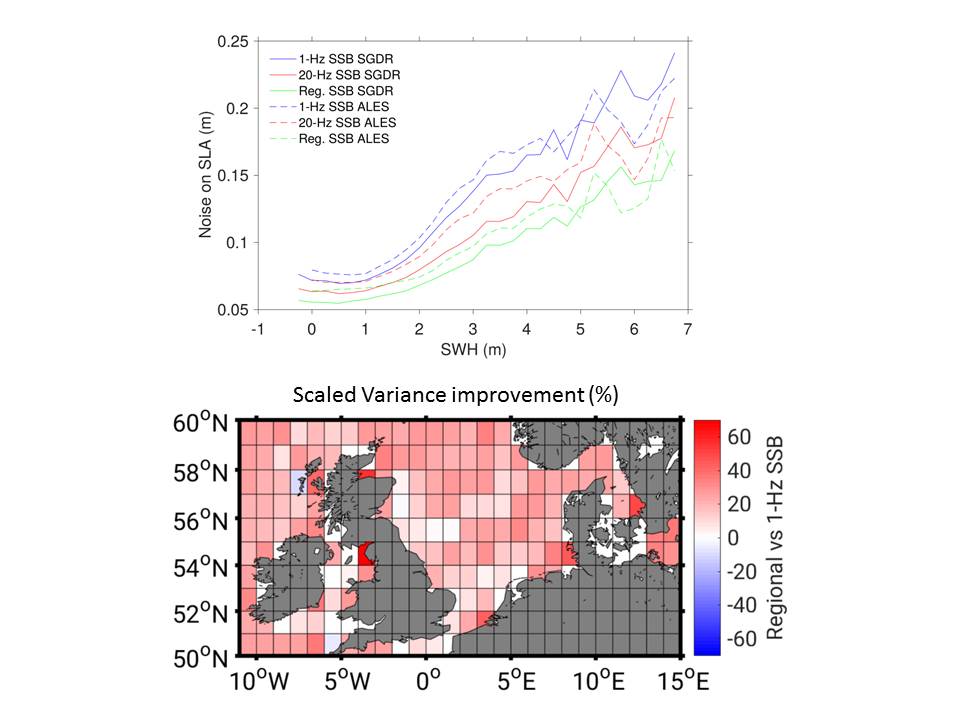Abstract's details
Improving the precision of sea level data from satellite altimetry with high-frequency and regional Sea State Bias corrections
Event: 2018 Ocean Surface Topography Science Team Meeting
Session: Instrument Processing: Propagation, Wind Speed and Sea State Bias
Presentation type: Oral
The sea state bias (SSB) is a large source of uncertainty in the estimation of sea level from satellite altimetry. It is still unclear to what amount it depends on errors in parameter estimations (“numerical” source) or to the wave physics (“physical” source). Up to now, the SSB correction has been computed and distributed using the averaged estimations of significant wave height and wind at 1-Hz posting frequency, rather than the original noisier retrieved data at a 20-Hz (high-rate) posting frequency.
In this study, performed in the context of the Sea Level CCI from ESA, by improving the application of this correction we compute 20-Hz sea level anomalies that are about 30% more precise (i.e. less noisy) than the current standards. The improvement is two-fold: first we prove that the SSB correction should be applied directly to the 20-Hz data (12 to 19% noise decrease); secondly, we show that by recomputing a regional SSB model (based on the 20-Hz estimations) even a simple parametric relation is sufficient to further improve the correction (further 14 to 19% noise decrease).
The whole Jason-1 mission is used, in order to have several years of data available and allow a comparison with the latest studies focused on SSB. We test our methodology using range, wave height and wind estimated with two retrackers: the MLE4 retracked-data available in the SGDR and the ALES retracked-data available in the OpenADB repository (https://openadb.dgfi.tum.de/). The regional SSB models are computed parametrically by means of a crossover analysis in the Mediterranean Sea and North Sea.
Correcting the high-rate data for the SSB reduces the correlation between retracked parameters that Sandwell and Smith (2005), who aimed at reducing this correlation by retracking, have shown. We demonstrate this by analysing the correlation of wave height and range estimations before and after the application of the new SSB corrections.
Regional variations in the proposed models might be due to physical causes such as the influence of the bathymetry (wave physics, tides) on the residuals used to model the correction. The variations in the empirical model with respect to the retracker used recall the need of a specific SSB correction for any retracker.
This study, while providing a significantly more precise solution to exploit high-rate sea level data, calls for a re-thinking of the SSB correction in both its physical and numerical component, gives robustness to previous theories and provide an immediate improvement for the application of satellite altimetry in two shelf seas. Therefore, although based on Jason-1 data, they are relevant for other altimetry missions.

In this study, performed in the context of the Sea Level CCI from ESA, by improving the application of this correction we compute 20-Hz sea level anomalies that are about 30% more precise (i.e. less noisy) than the current standards. The improvement is two-fold: first we prove that the SSB correction should be applied directly to the 20-Hz data (12 to 19% noise decrease); secondly, we show that by recomputing a regional SSB model (based on the 20-Hz estimations) even a simple parametric relation is sufficient to further improve the correction (further 14 to 19% noise decrease).
The whole Jason-1 mission is used, in order to have several years of data available and allow a comparison with the latest studies focused on SSB. We test our methodology using range, wave height and wind estimated with two retrackers: the MLE4 retracked-data available in the SGDR and the ALES retracked-data available in the OpenADB repository (https://openadb.dgfi.tum.de/). The regional SSB models are computed parametrically by means of a crossover analysis in the Mediterranean Sea and North Sea.
Correcting the high-rate data for the SSB reduces the correlation between retracked parameters that Sandwell and Smith (2005), who aimed at reducing this correlation by retracking, have shown. We demonstrate this by analysing the correlation of wave height and range estimations before and after the application of the new SSB corrections.
Regional variations in the proposed models might be due to physical causes such as the influence of the bathymetry (wave physics, tides) on the residuals used to model the correction. The variations in the empirical model with respect to the retracker used recall the need of a specific SSB correction for any retracker.
This study, while providing a significantly more precise solution to exploit high-rate sea level data, calls for a re-thinking of the SSB correction in both its physical and numerical component, gives robustness to previous theories and provide an immediate improvement for the application of satellite altimetry in two shelf seas. Therefore, although based on Jason-1 data, they are relevant for other altimetry missions.

Contribution: IPM_05_Passaro.pdf (pdf, 1530 ko)
Back to the list of abstract